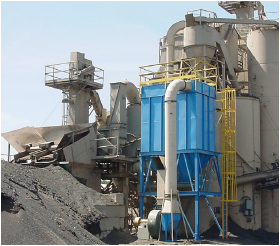The process of designing a system requires a comprehensive look at all of the specifics of the application and environmental requirements. The basic components of dust collection system design can be broken down into three areas:
- Containing or capturing the dust
- Conveying it to the collector
- Collecting the dust
Containing or Capturing the Dust
 The system design begins with identifying and mapping out those areas and processes that are generating dust. These collection points might include obvious dust-generating material handling equipment, such as conveyor transfers, bucket elevators, bagging, or pneumatic conveying.
The system design begins with identifying and mapping out those areas and processes that are generating dust. These collection points might include obvious dust-generating material handling equipment, such as conveyor transfers, bucket elevators, bagging, or pneumatic conveying.
The next step is to determine if the dust at each point should be controlled with a collection hood or contained within an enclosure. In either case, sufficient capture velocity must be generated to contain dust in the enclosure or move dust to the hood, including overcoming any surrounding air currents that would prevent the flow of dust into the hood.
Calculating the air volume is critical to proper dust collection system design. Insufficient air volume will result in inadequate dust collection and a disappointing installation. The basic formula for calculating air volume is Q= V x A. Q is the volume of air (cubic feet per minute), V is the desired velocity at the hood (feet per minute), and A is the open area of the hood (square feet) into which the air will be drawn. For example, if we have a hood opening that is 18" x 18" and have determined the correct velocity is 250 fpm, then we would calculate the air volume to be 2.25 square feet x 250 feet per minute, which equals 562.5 cubic feet per minute. Conversely, if we know the volume of air and the desired conveying velocity, we can calculate the optimal duct sizes using the same formula, which is expressed as A=Q /V.
Conveying: Keeping It Moving
 Once the dust has been captured, it is conveyed through ductwork to the dust collector. A key component of duct design is knowing the bulk density and loading (amount of material to be collected) of the dust being conveyed because these values affect the required conveying velocities in the ductwork. Conveying velocity (the speed of the air that is carrying the dust) should increase with an increase in the bulk density.
Once the dust has been captured, it is conveyed through ductwork to the dust collector. A key component of duct design is knowing the bulk density and loading (amount of material to be collected) of the dust being conveyed because these values affect the required conveying velocities in the ductwork. Conveying velocity (the speed of the air that is carrying the dust) should increase with an increase in the bulk density.
The best way to design an efficient system is to limit the amount of ductwork and the areas where additional air flow resistance and turbulence can be created, such as elbows or other transitions.
System static pressure is calculated by adding the combined resistance of the worst case of an inlet duct, including elbows and transitions, plus pressure drop across the dust collector, the fan outlet duct and stack, or any ductwork that is used to return air to the facility if a stack is not used. Once the required air volume (CFM) and system static pressure (inches of water column) for the system are defined, the correct dust collector can be selected.
Collection: Choosing a Well-Balanced, Efficient System
Selection of the dust collector model involves understanding the type of dust, particle size (microns), inlet dust loading (pounds/hour), temperature, chemical composition of the gas or air, and the desired outlet emission rate (grains/standard cubic foot or pounds/hour.)
The final design consideration is the selection of the exhaust fan used to move the dust-laden air from the collection points through the ductwork and through the dust collector. The fan or blower is sized to generate the design air flow at the calculated static pressure.
To learn more about designing an efficient dust-collection system, including modifications for handling combustible dusts, download a free copy of the How to Design a Dust Collection System white paper.
Tags: dust collector system




